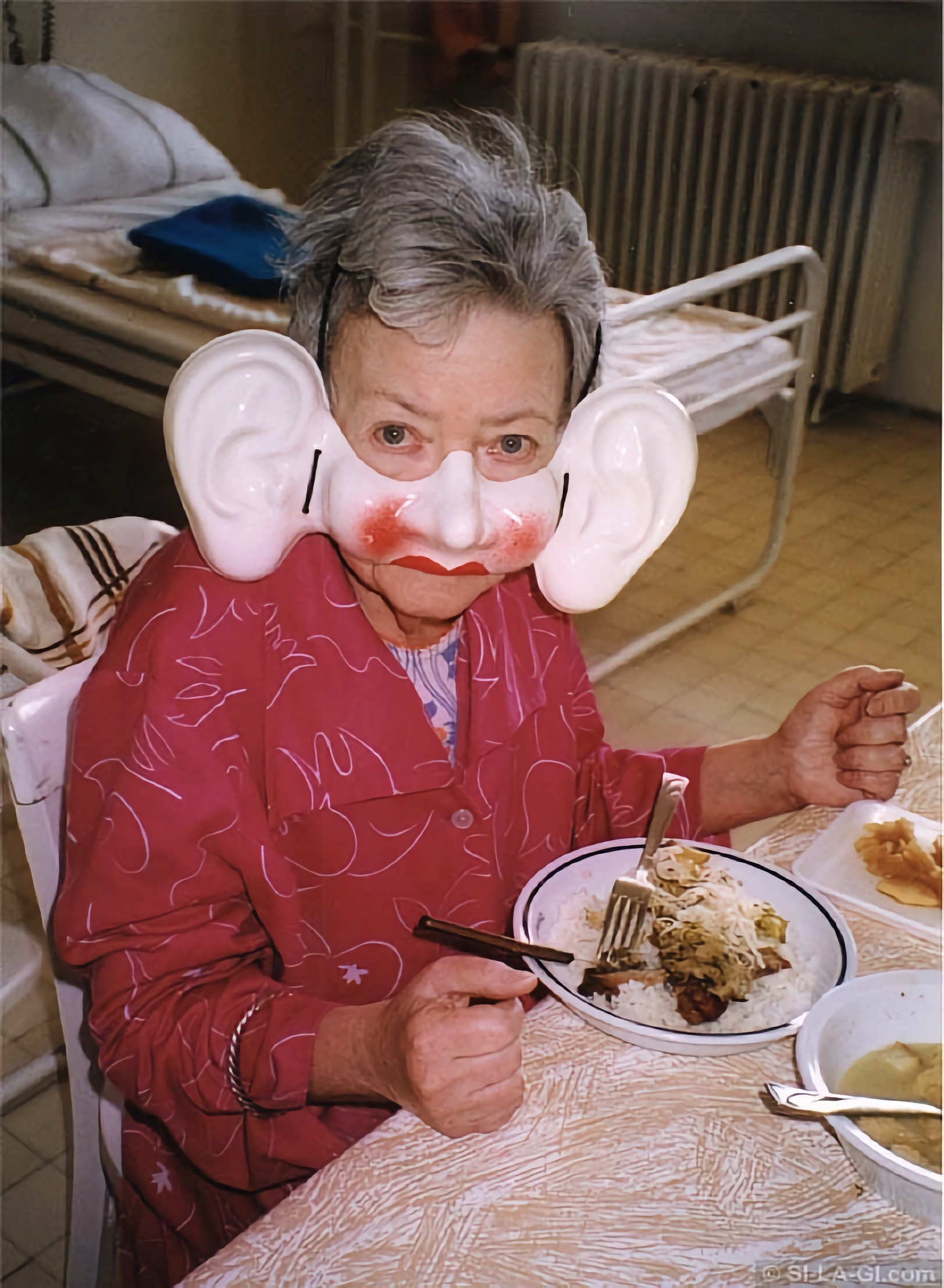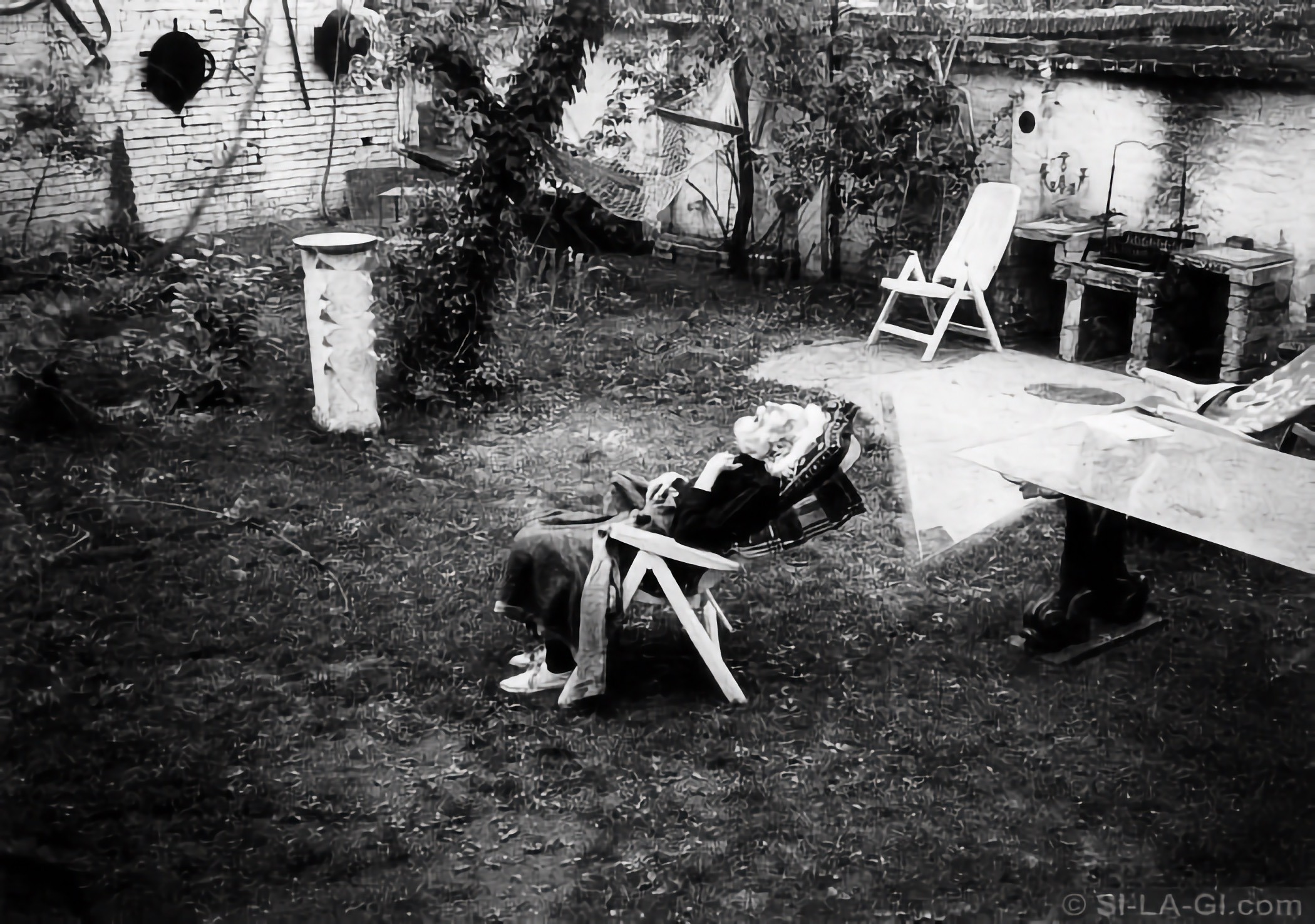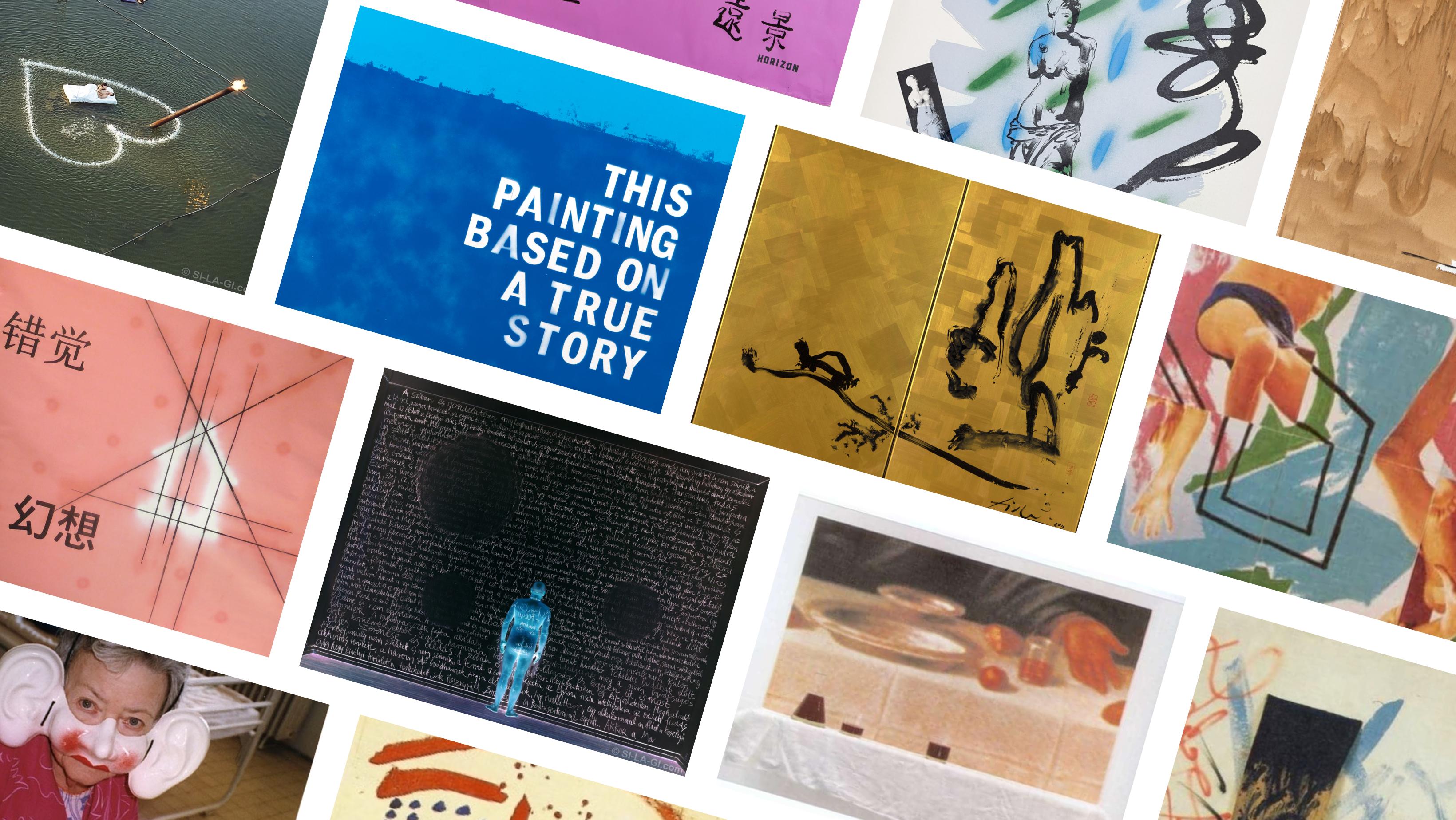Happiness and Suffering Are the Same, Both Transitory
Photography artwork, 199X
🇭🇺 Magyar verzió az angol szöveg alatt. Görgessen lejjebb. ⬇️
An old woman is sitting in a red dressing gown with a white print in a hospital room, in front of the supper she has begun. On her face, the comical New Year’s mask apparently constitutes a grotesque contrast to her situation of human tragedy: the rapid progress of aging and disease and the commencing disintegration of the body. As if alarmed by the threatening present, in her bewilderment she snatches at past joys and intimate games through her memories.
The mask, which at other times serves to disguise the personality, here, paradoxically, expresses it: one can cling for a moment to its firm materiality when confronted with the pressing reality of impersonal cosmic law. Via this contradictory effect, the mask is translated into a symbol of human existence. The personality within the framework of which we spend our life is itself a mask (persona), which simultaneously expresses and conceals the genuine nature of the existence.

The picture records the moment when this contradictory quality of life – at once comic and tragic, concealing and revealing, absurd and realistic, individual and universal, everyday and extraordinary – becomes visible to the viewer.
The old woman, her countenance expressing simultaneously intimate proximity and elusive, distant daydreaming, nevertheless, sees more than we viewers. She sees that one which will fuse the opposite ends of the spectrum once again, even if she cannot dare to formulate it, not to herself as yet: that there, approaching irrevocably, is – alas! – death.
Happiness and suffering are similar, both transitory II / Boldogság és szenvedés hasonló mindkettö mulandó II - 80 x 130 cm - 1996 - read the related text in the „Projects and Thoughts” section of the website [ kapcsolodo szöveg]
Late summer garden fragment, when Nature has attained its evolution in the wake of struggle, delivers its fruits, and slowly begins to crystallize and turns to decompose.
Within, an old man preparing to expire. His completely stiffened body is like a dried and withered shell, ready to molt. Around him, the traces of joy, the events of life and creation: perhaps it is even the smoke of the barbecue used last night which has left its impression upon the wall; a hammock which preserves the form of the body which earlier reposed within it, though it is now empty; upon the opposite wall, blackened objects, beginning to corrode.
A chair in a half-state of disintegration; at centre left, the pedestal of a sculpture, from which the sculpture has disappeared; on a table, a cast-off newspaper, whose contents, even if someone has read them, have been washed away by time. Nothing exists for eternity, in itself: the experiences of pleasure and pain emerge and dissolve again in dependence on their conditions, and our entire world, in its incessant evolution, takes form and decomposes in exactly the same way. And nevertheless, in the pain of expiration, when life’s energy abates, and the mind releases the maelstrom of phenomena, the silence becomes palpable in the background for a moment – the empire of the not-yet-apparent, from which, in the play of time, every fleeting phenomenon unfolds, and to whence they return.
The gaze of the old man already indulges in the reveries of this other world, beyond origin and mortality…
Text in Hungarian :
Egy öreg néni üldögél egy kórházi szobában megkezdett vacsorája elõtt, fehér mintás piros pongyolában. Arcán a komikus szilveszteri maszk látszólag groteszk ellentétet képez helyzetével: az öregség és betegség elhatalmasodásának, a test kezdõdõ felbomlásának emberi tragédiájával. Mintha a fenyegetõ jelentõl megriadva kapna zavarában elmúlt örömök, meghitt játékok emlékei után. A maszk, mely máskor a személyesség elrejtésére szolgál, itt paradox módon annak kifejezõjévé válik: szilárd anyagiságában egy pillanatra megkapaszkodhat az ember a személytelen kozmikus törvény szorongató valóságával szemben.
A maszkot ez az ellentmondásos hatása az egész emberi élet szimbólumává avatja. Hiszen a személyiség, melynek keretei között életünket leéljük, maga is maszk (perszóna), mely egyszerre fejezi ki és rejti el a lét valódi természetét. A kép egy olyan pillanatot örökít meg, amikor az életnek ez az ellentmondásos – egyszerre komikus és tragikus, elrejtõ és kitárulkozó, abszurd és valóságos, személyes és egyetemes, hétköznapi és rendkívüli – jellege a szemlélõ számára láthatóvá válik. Az öregasszony egyszerre intim közelséget és megfoghatatlan távolba révedést kifejezõ tekintete azonban már többet lát, mint mi nézõk. Látja azt, ami az ellentéteket ismét egységbe oldja, ha megfogalmazni még nem is meri magának: hogy ott közeleg visszavonhatatlanul, jaj, a halál.
Késõ nyári kertrészlet, amikor a természet a kibontakozás küzdelmei nyomán beérett, kihordta gyümölcseit, s lassan kristályosodni kezd és oszlásba fordul. Benne elmúlásra készülõdõ öregember. Összegémberedett teste mint egy kiszáradt és elfonnyadt, lehullni készülo héj. Körülötte örömök, életesemények, alkotások nyomai: talán még tegnap este is használt grillsütő füstjének lenyomata a falon; egy függõágy, mely õrzi a korábban benne heverõ test alakját, de már üres; a szemközti falon elfeketedett, korrodálódásnak indult tárgyak.
Szétesõfélben lévõ szék; balra középen egy szobor alapzata, melyrõl eltűnt a szobor; az asztalon eldobott újság, melynek tartalmát, ha valaki olvasta is, már elmosta az idõ. Semmi sem létezik véglegesen, önmagában: az örömök és bánatok tartalmai feltételeik függvényében bontakoznak ki és oldódnak fel ismét, s ugyanígy képzõdik és bomlik fel szakadatlan alakulásban egész világunk. És mégis, az elmúlás sajgásában, amikor elcsitulnak az életenergiák, és a tudat a jelenségek örvényét elengedi, a háttérben egy pillanatra tapinthatóvá válik a csend – a meg-nem-nyilvánultság birodalma, amelyből az idõ játékában minden tûnõ jelenség kibontakozik, s ahová visszatér. Az öregember tekintete már ebbe a másik világba réved, túl keletkezésen és elmúláson…

